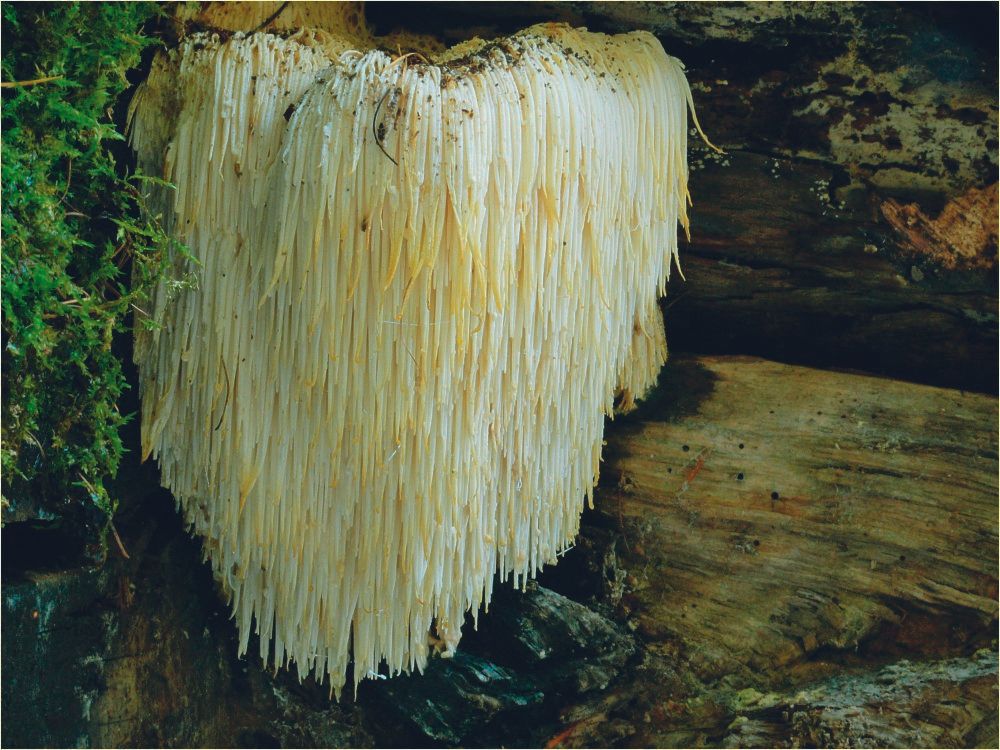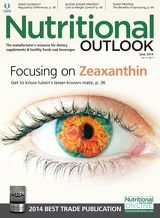Ingredient Spotlight: Lion's Mane Mushroom
Lion's mane mushroom, also known as hedgehog mushroom, has been used for centuries in traditional Chinese medicine.

Lion’s mane mushroom (Hericium erinaceus), also known as hedgehog mushroom, has been used for centuries in traditional Chinese medicine and as a food in Asia. In China, it is known as hou tou gu, and in Japan as yamabushitake. The mushroom has a distinctive appearance, with what appears to be a large mass of long tendrils similar to a shaggy lion’s mane. (The entire length of each tendril is attached to the mushroom’s body.) Other names for this mushroom may refer to its similar shape or appearance to a pom pom or a monkey’s head.
Lion’s mane mushroom is white in color when fresh, but turns a rusty brown or creamy color when dried. In culinary use, it’s sometimes compared to lobster or crab in taste and texture, with a mild sweetness.1,2 The mushroom is commercially grown on oak logs, miller’s bran, beech sawdust, and soybean substrates.3
Medicinal Uses
In traditional medicine, lion’s mane mushroom is used for promoting digestive health, including improving stomach and liver function, liver protection, and helping with peptic and duodenal ulcers and chronic gastric inflammation. It is also used for alleviating mental apathy (neurasthenia) and as a restorative health tonic.3
In modern clinical use, lion’s mane mushroom is known as a dietary supplement based on positive human clinical studies for brain health, memory, and mood.4,5 Lion’s mane mushroom has been shown to increase neurotrophic activities by stimulating nerve or brain cell growth, which could possibly be responsible for the mushroom’s purported brain-strengthening and antidepressant effects.6
The body’s nerve growth factor (NGF) system produces proteins that help to maintain the central nervous system’s cholinergic system in the forebrain. The forebrain is where most decision-making, memory, and higher thinking take place. Research shows that the forebrain size decreases in cases of Alzheimer’s disease. The bioactives in lion’s mane mushroom known as hericenones (aromatic molecules) and erinacines (diterpene compounds) can spur production of NGF in nerve cells, thus helping to maintain the cholinergic system and forebrain function.
An in vitro study found that lion’s mane extract at a concentration of only 0.0001%, when added to NGF in brain cell cultures, stimulated the production of more NGF and caused specialized nerve cells to increase their growth by 60%.6 This effect may pose potential for neurodegenerative diseases such as amyotrophic lateral sclerosis (Lou Gehrig’s disease), Parkinson’s disease, multiple sclerosis, and Alzheimer’s disease.
When the effects of lion’s mane and more than 20 other brain-improving culinary–medicinal mushrooms (including the 80 different bioactive secondary metabolites they contain) were tested on brain biochemical pathways, numerous protective and regenerative effects were found. These effects included reductions in beta-amyloid–induced neurotoxicity (the toxic protein implicated in Alzheimer’s disease–related dementia); acetylcholine neurotransmitter–protective effects; stimulation of neurite outgrowth; increased NGF synthesis; as well as neuroprotective, antioxidant, and anti-inflammatory effects.7
Moreover, animals given lion’s mane extract that had nerve crush injury exhibited recovery of hind-limb function and normal toe-spreading. They also showed regeneration of axons (nerve fibers) and re-innervation of motor endplates/neuromuscular junction in extensor digitorum longus muscle (in the front of the leg) in the early stages of recovery.8 One of the pathways was modulating the MAP kinase (MAPK) enzyme.
While the cognitive benefits of lion’s mane mushroom have been better studied, newer animal studies and in vitro studies hint that there could possibly be other potentially associated health benefits.
Cholesterol Reduction
A cell wall polysaccharide produced by a special, submerged culture of lion’s mane mushroom was found in an animal study to lower cholesterol by 32%, LDL cholesterol by 45.4%, and triglycerides by 34.3%, and to raise the “good” HDL cholesterol by 31%.9 The researchers proposed that the mushroom’s constituents helped to lower cholesterol production via the hepatic HMG-CoA reductase pathway, reducing the amount of this enzyme by 20%.
Immune Support
Although an animal study examining the antibacterial effects of lion’s mane extract against Salmonella bacteria did not find a direct effect, researchers did find, in the two-part study’s cell culture portion, that lion’s mane extract indirectly reduced mortality by increasing host resistance to infection and increasing white blood cell uptake of bacteria.10 This immune-boosting effect happened by increasing the macrophage cells’ ability to engulf the bacteria for subsequent destruction, as shown by higher colony-forming unit (CFU) counts inside the macrophage cells. Within cell culture, bacterial counts increased after 4 and 8 hours of the initial infection, but when the cells were treated with lion’s mane extract, they exhibited greater activity against the bacteria compared to control. Researchers looked at parameters such as greater inducible nitric oxide synthase mRNA activity. Beta-glucan is one of the actives in the mushroom extract known to stimulate innate immune cells.10
Anticancer Effects
Both in vitro and animal studies suggest that lion’s mane mushroom extract may have potent anti-cancer effects. These effects were found to be stronger against three gastrointestinal cancers compared to effects from a common chemotherapy drug, 5-FU (fluorouracil), when lion’s mane extract was used at its maximum tolerated dose (25–30 mg/kg/day). Liver, colorectal, and gastric cancers were tested as cell lines and implanted in tumor xenografts.11
The study revealed 22 different phytocompounds found in the active cancer cell–killing lion’s mane extract, including cyclic dipeptides, indole alkaloids, pyrimidines, flavones, anthraquinones, amino acid derivatives, and phenolic compounds. In the in vivo tumor xenograft studies, significant antitumor efficacy was shown, without toxicity to the host.11
Ulcers
A rat study on the effects of lion’s mane water extract on alcohol-induced ulcers showed a significant reduction of the ulcer area, as well as protection against gastric mucosa injury by maintaining levels of antioxidant enzymes.12
An in vitro study found that lion’s mane mushroom extract was active against nine clinical strains of H. pylori, the bacteria implicated in the cause of 85% of ulcers. A mere 0.02% concentration was needed to cause 50% bactericidal activity.13
Blood Sugar
In streptozotocin (STZ)-induced diabetic rats whose pancreases were damaged by a toxic agent, a water extract of lion’s mane given for several weeks caused a significant decrease in serum glucose level and a significant rise in serum insulin levels. The extract also reduced blood lipid abnormalities while increasing antioxidant enzymes in the liver.14
Wound Healing
An animal study used a topical application of a water extract of the mushroom at concentrations of 20, 30, and 40 mg/ml (between 2%-4% concentration). Control groups were topically applied with 0.2 ml of sterilized distilled water or the mushroom extract on a 2-cm-diameter neck wound. The lion’s mane groups had less scar tissue area at wound enclosure, and the healed wounds had fewer white blood cells (indicating less infection or pus formation) and greater levels of collagen. They also contained a greater density of new blood vessels.15
Future Potential
Lion’s mane mushroom extract is an exciting new nutraceutical that may have many potential health benefits. Some of the health effects, such as memory enhancement and mood improvement, are demonstrated in human clinical studies, while numerous animal and test tube studies point to a wide range of other potential health benefits. Further studies based on a human clinical design are needed to ascertain more precisely efficacy and proper dosages.
Photo ©Lebrac/Wikimedia Commons/CC-BY-SA-3.0
References
1. P Stamets, Growing Gourmet and Medicinal Mushrooms, Random House, 2000.
2. G Halpern, Healing Mushrooms: Effective Treatments for Today's Illnesses Square One Publishers, Jan 1, 2007, p. 155
3. R Rogers, The Fungal Pharmacy: The Complete Guide to Medicinal Mushrooms and Lichens, North Atlantic Books 2011, p. 212.
4. M Nagano et al., “Reduction of depression and anxiety by 4 weeks Hericium erinaceus intake," Biomedical Research, vol. 31, no. 4 (August 2010): 231–237.
5. K Mori et al., “Improving effects of the mushroom Yamabushitake (Hericium erinaceus) on mild cognitive impairment: a double-blind placebo-controlled clinical trial,” Phytotherapy Research, vol. 23, no. 3 (March 2009): 367–372.
6. PL Lai et al., “Neurotrophic properties of the lion's mane medicinal mushroom, Hericium erinaceus (Higher Basidiomycetes) from Malaysia." International Journal of Medicinal Mushrooms, vol. 15, no. 6 (2013): 539–554
7. CW Phan et al., “Therapeutic potential of culinary-medicinal mushrooms for the management of neurodegenerative diseases: diversity, metabolite, and mechanism.” Critical Reviews in Biotechnology. Published online ahead of print Mar 24, 2014.
8. KH Wong et al., “Neuroregenerative potential of lion's mane mushroom, Hericium erinaceus (Bull.: Fr.) Pers. (higher Basidiomycetes), in the treatment of peripheral nerve injury (review),” International Journal of Medicinal Mushrooms, vol. 14, no. 5 (2012): 427–44.
9. BK Yang et al., “Hypolipidemic effect of an Exo-biopolymer produced from a submerged mycelial culture of Hericium erinaceus," Bioscience, Biotechnology, and Biochemistry, vol. 67, no. 6 (June 2003): 1292–1298.
10. SP Kim et al., “Hericium erinaceus mushroom extracts protect infected mice against Salmonella Typhimurium-Induced liver damage and mortality by stimulation of innate immune cells.” Journal of Agricultural and FoodChemistry, vol. 60, no. 22 (June 6, 2012): 5590–5596.
11. G Li et al., “Anticancer potential of Hericium erinaceus extracts against human gastrointestinal cancers.” Journal of Ethnopharmacology, vol. 153, no. 2 (April 2014):521–530.
12. JY Wong et al., “Gastroprotective effects of lion's mane mushroom Hericium erinaceus (Bull.:Fr.) Pers. (Aphyllophoromycetideae) extract against ethanol-induced ulcer in rats,” Evidence-Based Complementary and Alternative Medicine. Published online November 5, 2013.
13. X Shang et al., “In vitro anti-Helicobacter pylori effects of medicinal mushroom extracts, with special emphasis on the Lion's Mane mushroom, Hericium erinaceus (higher Basidiomycetes),” International Journal of Medicinal Mushrooms, vol. 15, no. 2 (2013): 165–174.
14. B Liang et al., “Antihyperglycemic and antihyperlipidemic activities of aqueous extract of Hericium erinaceus in experimental diabetic rats," BMC Complementary and Alternative Medicine (October 3, 2013): 253.
15. MA Abdulla et al., “Potential activity of aqueous extract of culinary-medicinal Lion's Mane mushroom, Hericium erinaceus (Bull.: Fr.) Pers. (Aphyllophoromycetideae) in accelerating wound healing in rats,” International Journal of Medicinal Mushrooms, vol. 13, no. 1 (2011): 33–39.
